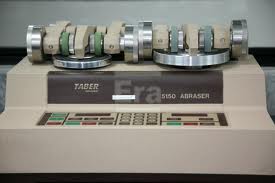ASTM D3389
Standard Test Method for Coated Fabrics Abrasion Resistance (Rotary Platform Abrader)
ASTM D3389 testing is offered by Micom as part of its coating testing services. ASTM D3389—Standard test method for coated fabrics abrasion resistance (rotary platform abrader)—describes a procedure which can assess the abrasion resistance of a fabric coated with rubber or plastics through the rotating action of two abrasive wheels present on a rotary platform tester. Lastly, this practice is similar to the ASTM D-4060 standard.
 Use and factors to be considered for ASTM D3389:
Use and factors to be considered for ASTM D3389:
The goal of ASTM D3389 is to assess the abrasion resistance of the specimen by exposing the latter to the erosive action of two abrasive wheels. More specifically, this test consists of wearing down the coating present on the sample through the rotary movement of the abrasive wheels until the endpoint has been achieved. In fact, the endpoint may be either a predetermined number of revolutions or the attainment of the first yarn. At that moment, it is possible to characterize the mass loss during the process and wear index of the material. Lastly, those two attributes render the possibility to compare the relative performance of multiple materials which have been exposed to the same conditions.
The main factors that have to be considered when running this test are: the type and the amount of finishing of the material, the type of abradant, the mounting or tension of the specimen and the pressure between the abradant and the sample.
Typical Experimental parameters for ASTM D3389 testing:
The number of specimens required is five replicates unless otherwise specified. The sample sizes must have a diameter of 110 mm (4 ½ in.) with a 6-mm (¼ in.) hole in the center. Table 1 lists the typical parameters for ASTM D3389 testing.
Table I : Typical parameters for ASTM D3389 testing
| Parameters | Specifications | |
| Platform speed | For 110 V and 60 Hz 7.5 ± 0.21 rad/s 72 ± 2 rpm | For 230 V and 50 Hz 6.9 ± 0.21 rad/s 60 ± 2 rpm |
| Vertical force against the specimen | Without auxiliary masses 2.45 N (250 gf) per wheel | With auxiliary masses 4.9 N (500 gf) per wheel Or 9.8 N (1000 gf) per wheel |
| Number of cycles | To be specified or until the first yarn is reached | |
| Test conditions | In compliance with the ASTM D1349 practice | |
Other test methods related to ASTM D3389 please see coating testing.

